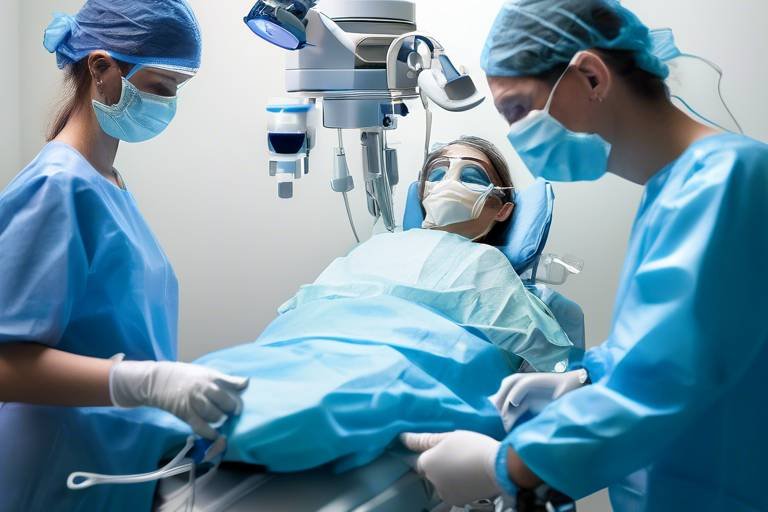Ensuring Safety During Anesthesia: Precautions to Take
When it comes to undergoing surgery, one of the most significant concerns for patients is the safety of the anesthesia process. It’s like trusting someone to drive your car while you take a nap; you want to be sure they know what they’re doing! Ensuring safety during anesthesia involves a series of precautions that healthcare professionals take to minimize risks and enhance patient outcomes. From thorough pre-operative assessments to effective monitoring techniques and diligent post-operative care, every step is crucial. Let’s dive deeper into these essential precautions that help keep patients safe and sound during their surgical journeys.
Before any anesthesia is administered, a comprehensive pre-operative assessment is paramount. Think of it as laying the groundwork for a solid building; without it, everything could come crashing down. This assessment typically involves a detailed review of the patient’s medical history, physical examinations, and any necessary tests. For instance, if a patient has a history of heart problems, the anesthesiologist will need to tailor the anesthesia plan accordingly. It's essential to identify any potential risks that could complicate the anesthesia process.
During this phase, patients are often asked to provide information about:
- Previous reactions to anesthesia
- Current medications and allergies
- Chronic health conditions
By gathering this information, healthcare providers can create a personalized anesthesia plan that caters specifically to the patient's needs, ensuring a safer experience.
Once the anesthesia begins, monitoring techniques come into play, acting like a safety net to catch any potential issues before they escalate. It’s crucial to keep a close eye on vital signs, as they provide real-time insights into the patient's condition. Think of it as having a smoke detector in your home; it alerts you to danger before it becomes a disaster. The various monitoring techniques employed during anesthesia include tracking heart rate, blood pressure, and oxygen saturation, which are essential parameters guiding anesthetic management.
Monitoring vital signs is not just a routine task; it’s a lifeline during surgery. These parameters help the medical team detect any abnormalities that could indicate complications. For example, a sudden drop in blood pressure could signal a reaction to the anesthesia or an underlying issue that needs immediate attention. By continuously monitoring these signs, the anesthesia team can ensure that they are prepared to respond quickly and effectively to any changes in the patient’s condition.
One of the most critical tools in the monitoring arsenal is the electrocardiogram (ECG). This device continuously tracks the heart's electrical activity, providing vital information about the patient’s cardiac status. Think of it as a window into the heart’s rhythm; if something goes wrong, the ECG will reveal it. The significance of ECG monitoring cannot be overstated, as it allows for real-time data analysis and ensures that any cardiac issues are addressed promptly. This is especially important for patients with pre-existing heart conditions, where even a minor deviation could lead to serious complications.
Another essential monitoring technique is capnography, which measures the levels of carbon dioxide in the patient’s exhaled air. This tool is crucial for assessing respiratory function during anesthesia. Imagine it as a barometer for breathing; it helps detect hypoventilation, which can lead to increased carbon dioxide levels and, subsequently, respiratory distress. By keeping a close watch on these levels, the anesthesia team can make necessary adjustments to ventilation, ensuring that the patient maintains adequate oxygenation throughout the procedure.
After the surgery is complete, the focus shifts to post-operative care, which is just as vital as the pre-operative and intra-operative phases. This stage is all about ensuring that patients safely emerge from anesthesia and begin their recovery journey. Post-operative monitoring typically involves assessing vital signs, managing pain, and observing for any adverse reactions to the anesthesia. It’s essential to provide a supportive environment where patients can wake up comfortably and safely, minimizing any potential risks associated with anesthesia recovery.
Educating patients about anesthesia is a fundamental aspect of ensuring safety. Knowledge is empowering, and when patients are well-informed, they can provide better consent and understand the process. Discussing the risks, benefits, and what to expect before and after the procedure can alleviate anxiety and foster trust between the patient and the healthcare team. Think of it as giving patients the roadmap to their surgical journey; the more they know, the less daunting the experience becomes.
Despite all precautions, emergencies can still arise during anesthesia. This is why being prepared is essential. Healthcare facilities must have protocols and equipment in place to handle unexpected situations effectively. This involves regular training and simulations for the anesthesia team to ensure they know how to react quickly and efficiently in a crisis.
A well-stocked crash cart can be the difference between life and death in an emergency. It should include critical medications and tools such as:
- Adrenaline for cardiac arrest
- Defibrillator for arrhythmias
- Airway management tools
Having these essentials readily available ensures that the team is prepared to act swiftly should the need arise.
Regular training and simulation exercises are vital for enhancing team readiness. These sessions not only improve response times but also foster coordination among team members during crises. Practicing emergency protocols in a simulated environment helps build confidence and ensures that everyone knows their role, making them more effective in real-life situations.
Q1: What should I expect during the anesthesia process?
A: You will undergo a pre-operative assessment where your medical history will be reviewed. During surgery, your vital signs will be closely monitored, and you will be cared for by an experienced anesthesia team.
Q2: Are there risks associated with anesthesia?
A: Yes, like any medical procedure, anesthesia carries risks. However, thorough assessments and monitoring significantly reduce these risks.
Q3: How can I prepare for anesthesia?
A: Discuss your medical history with your healthcare provider, follow pre-operative instructions, and ask any questions you may have to ease your concerns.

Pre-Operative Assessments
When it comes to ensuring a safe anesthesia experience, are the cornerstone of the entire process. Think of it like laying a solid foundation before building a house; without it, everything could come crashing down. These assessments are not just a box to check off; they are a comprehensive evaluation meant to identify any potential risks that could affect the patient's safety during surgery. This is where the magic begins, as healthcare providers gather crucial information about the patient’s health status.
First and foremost, a thorough patient history is essential. This includes understanding the patient’s medical background, previous surgeries, any allergies, and current medications. It’s like piecing together a puzzle; each piece of information helps create a clearer picture of the patient’s health. For instance, knowing if a patient has a history of respiratory issues can significantly influence the anesthesia plan. Furthermore, the physical examination plays a pivotal role. By assessing vital signs and conducting necessary tests, anesthesiologists can pinpoint any abnormalities that may pose risks during the procedure.
Additionally, certain pre-operative tests may be necessary to further evaluate the patient’s condition. These tests can include blood work, imaging studies, or cardiac evaluations. Each test serves a specific purpose and helps the anesthesia team devise a tailored approach. For example, if a patient has elevated blood pressure, it may require adjustments in the anesthesia plan to ensure optimal management during surgery. The goal is to create a personalized anesthesia strategy that minimizes risks and maximizes safety.
Moreover, engaging the patient in this process is crucial. It’s not just about collecting data; it’s about fostering a relationship of trust and transparency. When patients understand why these assessments are necessary, they are more likely to feel at ease. A well-informed patient is a less anxious patient, which can positively impact their overall experience. Therefore, healthcare providers should take the time to explain the significance of each assessment and address any concerns the patient may have.
In summary, pre-operative assessments are not merely procedural formalities; they are essential steps that pave the way for a safe anesthesia experience. By meticulously gathering patient history, conducting thorough physical examinations, and performing necessary tests, healthcare providers can identify potential risks and tailor their approach accordingly. This proactive strategy not only enhances patient safety but also contributes to better overall outcomes.

Monitoring Techniques
When it comes to ensuring patient safety during anesthesia, effective monitoring techniques play a crucial role. Anesthesia is a delicate balance; it's not just about putting someone to sleep but also about keeping them safe and stable throughout the procedure. Imagine you're on a roller coaster—there are thrilling ups and downs, but the safety harness is what keeps you from flying off. In the same way, monitoring techniques are the safety harnesses that protect patients during their anesthesia journey.
One of the most vital aspects of monitoring is the continuous tracking of a patient's vital signs. These signs include heart rate, blood pressure, and oxygen saturation. Each parameter provides a piece of the puzzle, helping the anesthesiologist make informed decisions. For instance, if a patient's heart rate suddenly spikes, it could indicate pain or anxiety, prompting the team to take immediate action. Conversely, a drop in blood pressure might signal an adverse reaction to the anesthesia, requiring swift intervention.
To give you a clearer picture, let's break down some of the essential monitoring techniques:
| Monitoring Technique | Purpose |
|---|---|
| Vital Sign Monitoring | Tracks heart rate, blood pressure, and oxygen saturation to ensure stability. |
| Electrocardiogram (ECG) | Monitors electrical activity of the heart to detect abnormalities. |
| Capnography | Measures carbon dioxide levels to assess respiratory function. |
Each of these techniques serves a specific purpose, but together, they create a comprehensive safety net. The anesthesiologist is like a conductor, orchestrating the symphony of monitoring tools to ensure everything runs smoothly. They rely on real-time data to make decisions that can significantly impact the patient's outcome. For example, if capnography indicates rising carbon dioxide levels, it could mean the patient is not ventilating properly, prompting the team to adjust the ventilation settings immediately.
Moreover, the importance of team communication cannot be overstated. All members of the surgical team must be on the same page, sharing information about the patient's status and any changes in vital signs. This collaboration is akin to a well-rehearsed dance; when everyone knows their role, the performance is seamless, and the patient remains safe.
In summary, monitoring techniques during anesthesia are not just about observing numbers on a screen; they are about ensuring a patient's safety and comfort throughout their experience. With the right tools and teamwork, the risks associated with anesthesia can be minimized, allowing patients to focus on healing rather than worrying about what happens behind the scenes.

Vital Sign Monitoring
Monitoring vital signs during anesthesia is not just a routine task; it is a lifeline for patients undergoing surgical procedures. Think of it like a conductor guiding an orchestra, ensuring that every note is played at the right moment. Vital signs, such as heart rate, blood pressure, and oxygen saturation, provide critical insights into a patient’s physiological state and are essential for guiding anesthetic management. Imagine being on a roller coaster—your heart rate spikes, your blood pressure fluctuates, and you need to know if you’re safe to continue the ride. In the same way, anesthesiologists rely on these indicators to determine whether a patient is stable or experiencing complications.
Heart rate monitoring is particularly important as it reflects the heart's response to the stress of surgery. A sudden increase may indicate pain, anxiety, or even an adverse reaction to anesthesia, while a decrease could signify a serious issue like bradycardia. Blood pressure is another vital sign that helps assess the overall cardiovascular health of the patient. Anesthesia can cause fluctuations in blood pressure, and it’s crucial for the medical team to respond promptly to any significant changes. Oxygen saturation, measured using a pulse oximeter, ensures that the patient is receiving adequate oxygen during the procedure. Low levels can be a red flag, signaling potential respiratory distress.
To illustrate the importance of these parameters, let’s take a look at a
| Vital Sign | Normal Range | Potential Issues |
|---|---|---|
| Heart Rate | 60-100 bpm | Tachycardia, Bradycardia |
| Blood Pressure | 90/60 to 120/80 mmHg | Hypotension, Hypertension |
| Oxygen Saturation | 95-100% | Hypoxemia |
In summary, monitoring vital signs is an essential aspect of anesthesia care. It allows healthcare professionals to make informed decisions and intervene quickly if any abnormalities arise. Just as a pilot relies on instruments to navigate through turbulent skies, anesthesiologists depend on these vital signs to ensure a smooth and safe surgical experience for patients. By keeping a close eye on these parameters, they can help prevent complications and promote better outcomes.

Electrocardiogram (ECG) Usage
The Electrocardiogram (ECG) is an essential tool in the realm of anesthesia, acting like a vigilant guardian over the heart's rhythm during surgical procedures. Imagine it as a watchful eye, constantly monitoring the electrical activity of the heart, ensuring everything is functioning smoothly. By providing real-time data, the ECG allows the anesthesia team to detect any irregularities that may arise, thus facilitating timely interventions if necessary.
During anesthesia, the heart can experience various stressors, such as changes in blood pressure or the effects of anesthetic agents. The ECG serves as a critical line of defense, alerting the medical team to potential cardiac complications. It’s not just about monitoring; it’s about proactive management. The information gleaned from the ECG can guide anesthetic management decisions, helping to tailor the approach to each patient's unique needs.
Here's why ECG usage is so vital during anesthesia:
- Real-Time Monitoring: Continuous ECG monitoring allows for immediate recognition of arrhythmias or ischemic changes, which can be life-threatening if unaddressed.
- Guiding Anesthetic Depth: Changes in the heart's electrical activity can indicate how deeply a patient is anesthetized, aiding in the adjustment of anesthetic agents.
- Patient Safety: By ensuring the heart is functioning correctly, the ECG minimizes the risk of complications during and after surgery.
Moreover, the ECG can be particularly beneficial for patients with pre-existing heart conditions. For instance, individuals with a history of arrhythmias or heart disease may require closer monitoring. The ECG provides a clear picture of how their heart is responding to anesthesia, giving the medical team the information they need to act swiftly if any issues arise.
In conclusion, the usage of ECG during anesthesia is not just a standard procedure; it is a critical component of patient safety. By continuously monitoring the heart’s electrical activity, the anesthesia team can ensure a stable and secure environment for the patient throughout the surgical experience. As technology advances, the integration of more sophisticated ECG devices will further enhance our ability to monitor and respond to cardiac changes, paving the way for even safer anesthesia practices in the future.
Q: What is an ECG?
A: An ECG, or electrocardiogram, is a test that measures the electrical activity of the heart, providing important information about its rhythm and function.
Q: Why is ECG monitoring important during anesthesia?
A: ECG monitoring is crucial because it helps detect any irregular heart rhythms or potential complications that can arise during anesthesia, allowing for immediate intervention if necessary.
Q: How does an ECG work?
A: An ECG works by placing electrodes on the skin that detect the electrical impulses generated by the heart. These impulses are then displayed as waves on a monitor, providing real-time data about the heart's activity.
Q: Are there any risks associated with ECG monitoring?
A: ECG monitoring is generally safe and non-invasive. However, some patients may experience skin irritation where the electrodes are placed.
Q: Can I see my ECG results?
A: Yes, patients can usually request to see their ECG results. Your healthcare team will explain what the results mean and how they relate to your overall health.

Capnography in Anesthesia
Capnography is a vital monitoring tool in the realm of anesthesia, providing real-time insights into a patient’s respiratory status. This technique measures the concentration of carbon dioxide (CO2) in exhaled air, which serves as a crucial indicator of ventilation and metabolic function. Imagine being able to see the very breath of life leaving a patient’s lungs; that’s what capnography offers—an immediate glimpse into how well a patient is ventilating and how effectively their body is metabolizing oxygen.
During anesthesia, the ability to monitor CO2 levels is essential for several reasons. First, it helps in detecting hypoventilation, a condition where a patient is not breathing adequately, leading to increased levels of CO2 in the bloodstream. This can be a silent danger, as patients under anesthesia may not exhibit obvious signs of distress. By utilizing capnography, anesthesiologists can quickly identify this issue and intervene before it escalates into a more serious problem.
Moreover, capnography also plays a role in confirming proper endotracheal tube placement. When a tube is correctly positioned in the trachea, the exhaled CO2 levels will show a characteristic waveform on the capnograph. If the tube is misplaced—say, in the esophagus—the CO2 levels will be significantly lower or absent, alerting the medical team to take immediate corrective action. This capability can be likened to having a reliable compass in uncharted waters; it guides practitioners to ensure that they are on the right path.
In addition to these critical functions, capnography can also provide insights into the patient’s metabolic state. For instance, changes in the CO2 levels can indicate various physiological responses, such as hypercapnia (elevated CO2) or hypocapnia (decreased CO2), which may arise due to various factors, including changes in ventilation, metabolic rate, or even certain medications. Understanding these nuances allows anesthesiologists to tailor their approach and interventions more accurately, ensuring a safer experience for the patient.
In summary, capnography is not just a monitoring tool; it is an essential lifeline during anesthesia that enhances patient safety and outcomes. As technology advances, the integration of capnography into routine anesthesia practice will likely become even more sophisticated, further solidifying its role as a cornerstone of effective patient monitoring.
- What is capnography? Capnography is a monitoring technique that measures the concentration of carbon dioxide in exhaled air, providing real-time information about a patient’s respiratory status.
- How does capnography help during anesthesia? It helps detect hypoventilation, confirms endotracheal tube placement, and provides insights into the patient’s metabolic state.
- Is capnography used in all anesthesia procedures? While it is highly recommended, the use of capnography may vary based on the type of procedure and the patient's condition.
- What happens if CO2 levels are abnormal? Abnormal CO2 levels can indicate respiratory issues, prompting immediate intervention by the medical team.

Post-Operative Care
Post-operative care is a critical phase in the anesthesia process, serving as the bridge between the surgical procedure and the patient’s recovery. After the anesthesia has worn off, patients often find themselves in a state of confusion or grogginess, which is entirely normal. However, this is the time when healthcare providers need to be particularly vigilant. Monitoring patients closely during this period can drastically reduce the risk of complications and ensure a smooth transition back to consciousness.
One of the primary goals of post-operative care is to ensure patient safety. This involves regular assessments of vital signs, including heart rate, blood pressure, and oxygen saturation levels. These parameters provide crucial information about the patient’s recovery status. For instance, a sudden drop in blood pressure could indicate hemorrhaging, while abnormal heart rhythms may signal cardiac distress. Therefore, continuous monitoring is essential during this phase.
In addition to vital signs, it’s important to assess the patient's level of consciousness and responsiveness. Using the Aldrete Score can help healthcare providers gauge how well the patient is recovering from anesthesia. This scoring system evaluates criteria such as activity, respiration, circulation, consciousness, and oxygen saturation. A higher score typically indicates that the patient is recovering well.
| Criteria | Score 0 | Score 1 | Score 2 |
|---|---|---|---|
| Activity | Unresponsive | Moves limbs | Fully awake |
| Respiration | Apnea | Shallow breathing | Normal breathing |
| Circulation | BP < 90/60 | BP 90-140/60-90 | BP > 140/90 |
| Consciousness | Unresponsive | Confused | Alert |
| Oxygen Saturation | < 90% | 90-92% | > 92% |
Moreover, addressing pain management is a crucial component of post-operative care. Patients may experience discomfort as the anesthesia wears off, and it’s vital for healthcare providers to assess their pain levels regularly. Effective pain management not only enhances patient comfort but also facilitates quicker recovery times. Options for pain relief may include medications such as opioids or non-steroidal anti-inflammatory drugs (NSAIDs), tailored to the individual patient's needs.
Another essential aspect is hydration and nutrition. Post-operative patients often have restrictions on food and drink intake immediately after surgery. However, once they are stable and alert, it is important to gradually reintroduce fluids and light meals. This helps in restoring energy levels and promoting overall recovery. Monitoring for any signs of nausea or vomiting is also critical, as these can complicate the recovery process.
Communication plays a vital role in post-operative care. Patients should be encouraged to express any concerns or symptoms they may be experiencing. Healthcare providers should take the time to explain the recovery process, what to expect, and any potential complications that may arise. This transparency not only reassures patients but also empowers them to take an active role in their recovery.
In conclusion, post-operative care is not just about monitoring vital signs; it encompasses a holistic approach to patient recovery. By focusing on safety, pain management, hydration, and effective communication, healthcare providers can significantly enhance patient outcomes and ensure a smoother recovery journey.
- What should I expect after waking up from anesthesia? Most patients feel groggy and may experience confusion. It’s important to rest and allow your body to recover.
- How long will I be monitored after surgery? Monitoring typically continues until you are stable and fully awake, which can vary from patient to patient.
- What if I experience pain after the procedure? Communicate with your healthcare team; they can provide medications to help manage your pain effectively.
- When can I eat or drink after surgery? You will receive guidance on when to resume eating and drinking, usually once you are alert and stable.

Patient Education
When it comes to anesthesia, plays a pivotal role in ensuring a safe and successful experience. Imagine walking into a room filled with unfamiliar equipment and a team of professionals in scrubs, ready to perform a procedure. It can be daunting, right? That's why understanding what to expect before, during, and after anesthesia can significantly reduce anxiety and promote a sense of control for the patient.
Before any procedure, patients should engage in a comprehensive discussion with their healthcare provider. This conversation should cover several critical aspects, including:
- Risks: Every medical procedure comes with its set of risks. It's essential for patients to be aware of potential complications associated with anesthesia, such as allergic reactions or breathing difficulties.
- Benefits: Understanding the advantages of anesthesia can help patients appreciate its necessity. For instance, anesthesia allows for painless procedures, which can lead to quicker recoveries and better outcomes.
- What to Expect: By outlining the steps of the anesthesia process, patients can mentally prepare themselves. This includes knowing about the types of anesthesia that may be used, such as general or local anesthesia, and what sensations they might experience.
Moreover, educating patients about post-operative care is equally important. After the procedure, patients should be informed about:
- Signs of complications to watch for, such as excessive drowsiness or difficulty breathing.
- Instructions regarding pain management and any medications they might need.
- The importance of having someone accompany them home, especially if they received general anesthesia.
In addition to verbal communication, providing written materials can be beneficial. Handouts that summarize key points about anesthesia can serve as a valuable reference for patients. These materials should be clear, concise, and easy to understand, avoiding complex medical jargon that might confuse the patient.
Ultimately, an informed patient is a safer patient. By fostering open communication and ensuring that patients feel comfortable asking questions, healthcare providers can enhance the overall anesthesia experience. It’s essential to remember that every patient is unique, and their concerns should be addressed individually to build trust and confidence in the care they are receiving.
To further assist patients in understanding anesthesia, here are some frequently asked questions:
| Question | Answer |
|---|---|
| What types of anesthesia are there? | There are several types, including general, regional, and local anesthesia, each suited for different procedures. |
| How long will I be under anesthesia? | The duration depends on the procedure but can range from a few minutes to several hours. |
| Will I feel any pain during the procedure? | No, anesthesia is designed to prevent pain during the procedure. |
| What should I do if I have concerns about allergies? | Discuss any known allergies with your healthcare provider during the pre-operative assessment. |

Emergency Preparedness
When it comes to anesthesia, being prepared for emergencies is not just a precaution; it's a necessity. The unpredictable nature of medical procedures means that anything can happen, and having a solid emergency plan can be the difference between a minor hiccup and a major crisis. Imagine being on a plane and suddenly hearing the captain say, "We have a situation." You want to know that the crew is ready to handle it, right? The same principle applies in the operating room.
In anesthesia practice, having protocols and equipment in place is crucial for effectively managing unexpected situations. Emergency preparedness involves not only having the right tools but also ensuring that the entire team is trained to respond swiftly and efficiently. This preparedness can significantly reduce the risks associated with anesthesia and improve patient outcomes.
One of the first steps in ensuring emergency preparedness is to maintain a well-stocked crash cart. This cart should be easily accessible and contain all the essential medications and tools required to address various emergency scenarios. Here’s a quick look at what should be included in a typical crash cart:
| Item | Purpose |
|---|---|
| Defibrillator | Used to restore normal heart rhythm in case of cardiac arrest. |
| Oxygen Supply | Essential for patients experiencing respiratory distress. |
| Medications (e.g., Epinephrine, Atropine) | Critical for treating various emergencies like anaphylaxis or bradycardia. |
| Airway Management Tools | Includes intubation kits and bag-valve masks to secure the airway. |
| IV Fluids | Used for resuscitation and maintaining blood pressure. |
Furthermore, the importance of team training and simulation cannot be overstated. Regular training sessions and simulation exercises allow the medical team to practice emergency protocols in a controlled environment. This not only helps familiarize everyone with the equipment and procedures but also enhances team coordination and response times during a real emergency. Think of it like a fire drill at school; you may not expect a fire to happen, but knowing how to respond can save lives.
During these training sessions, scenarios can be created that mimic real-life emergencies, allowing team members to practice their roles and responsibilities. This hands-on experience can be invaluable, as it builds confidence and ensures that everyone knows what to do when the pressure is on. Moreover, after-action reviews can help identify areas for improvement, ensuring that the team is always evolving and enhancing their preparedness.
In conclusion, emergency preparedness in anesthesia is not just about having the right equipment; it’s about creating a culture of readiness. By ensuring that both the tools and the team are prepared, healthcare providers can significantly improve patient safety and outcomes. So, the next time you think about anesthesia, remember: being prepared is half the battle won!
- What is a crash cart? A crash cart is a mobile unit that contains emergency medical supplies and equipment needed to respond to life-threatening situations.
- How often should the crash cart be checked? It is essential to check the crash cart regularly, ideally before every shift, to ensure all supplies are stocked and medications are not expired.
- What kind of training is necessary for anesthesia teams? Anesthesia teams should undergo regular training that includes emergency protocols, equipment usage, and simulation exercises to ensure effective response during emergencies.

Crash Cart Essentials
In the high-stakes world of anesthesia, being prepared for emergencies can mean the difference between life and death. A well-stocked crash cart is an essential component of any medical facility equipped to handle anesthesia. This cart is like a lifeline, containing critical medications and tools that can be swiftly accessed in the event of a crisis. Imagine a race against time where every second counts; having the right equipment at your fingertips can turn a potential disaster into a manageable situation.
So, what exactly should be included in a crash cart? First and foremost, it should be stocked with a variety of medications that are commonly required in emergencies. These include epinephrine for cardiac arrest, atropine for bradycardia, and amiodarone for arrhythmias. Additionally, the cart should contain antidotes for specific drug overdoses, such as naloxone for opioid reversal. To ensure that the team is prepared for any situation, the crash cart should also include intravenous (IV) fluids, syringes, and various sizes of needles.
Moreover, beyond medications, the crash cart should be equipped with essential tools like an automated external defibrillator (AED), airway management devices, and monitoring equipment. The AED is crucial for delivering electric shocks to restore normal heart rhythms, while airway devices, such as endotracheal tubes and bag-mask ventilation systems, are vital for ensuring that patients can breathe adequately during emergencies.
To keep everything organized and accessible, crash carts often come with a checklist that outlines the essential items. This checklist should be regularly reviewed and updated to ensure that nothing is expired or missing. Here’s a quick overview of what a typical crash cart might contain:
| Category | Items |
|---|---|
| Medications | Epinephrine, Atropine, Amiodarone, Naloxone, IV Fluids |
| Airway Management | Endotracheal Tubes, Bag-Mask Ventilation Systems |
| Monitoring Equipment | AED, Pulse Oximeter, Blood Pressure Monitor |
Finally, it is not enough to simply have a crash cart filled with the right items; the entire medical team must be familiar with its contents and know how to use each item effectively. Regular training sessions and simulations can significantly enhance the team's readiness to respond to emergencies. Just like a fire drill prepares you for a real fire, practicing with the crash cart ensures that when a crisis strikes, everyone knows their role and can act swiftly.
Q: What is a crash cart?
A: A crash cart is a mobile unit that contains essential medications and equipment needed to respond to medical emergencies, particularly during anesthesia.
Q: How often should the crash cart be checked?
A: The crash cart should be checked regularly, ideally daily, to ensure that all items are present, functional, and not expired.
Q: Who is responsible for maintaining the crash cart?
A: Typically, a designated healthcare professional, such as a nurse or anesthesiologist, is responsible for maintaining and checking the crash cart.
Q: What training is required for staff regarding the crash cart?
A: Staff should receive regular training on the contents of the crash cart, how to use each item, and participate in simulations to practice emergency response.

Team Training and Simulation
When it comes to ensuring safety during anesthesia, are absolutely vital. Think about it: just like a sports team practices plays to ensure they perform flawlessly during a game, medical teams must also engage in regular training to prepare for the unpredictable nature of surgical procedures. Effective communication and coordination among team members can be the difference between a routine surgery and a crisis situation.
Regular training sessions not only enhance the skills of individual team members but also foster a sense of unity and trust among them. This is crucial because, during high-stress situations, such as a patient experiencing an adverse reaction to anesthesia, every second counts. The ability to work together seamlessly can save lives. Simulation exercises, in particular, allow teams to practice emergency protocols in a controlled environment, which can significantly improve their response times in real-life scenarios.
During these simulations, various scenarios can be enacted, ranging from minor complications to major emergencies. This hands-on experience is invaluable. For example, a team might practice responding to a sudden drop in a patient's heart rate or an unexpected allergic reaction. By rehearsing these situations, team members can identify their roles, understand the equipment they need, and learn to communicate effectively under pressure.
Moreover, the use of technology in simulation training has revolutionized the way teams prepare for emergencies. Advanced simulators can mimic real patient responses, providing a realistic training experience. Teams can practice using different monitoring devices, such as ECGs and capnographs, in a safe setting where mistakes can be learned from without risking patient safety.
In addition to technical skills, simulation training also emphasizes the importance of emotional readiness. Team members learn to manage stress and maintain composure, which is essential during actual emergencies. By creating a culture of preparedness, healthcare facilities can ensure that their teams are not just skilled, but are also mentally equipped to handle crises.
To summarize, investing in team training and simulation is not just a checkbox on a compliance list; it is a crucial component of patient safety during anesthesia. By practicing together, healthcare teams can enhance their readiness, improve patient outcomes, and ultimately save lives. The question remains: is your team prepared for the unexpected?
- What is the purpose of team training in anesthesia?
Team training aims to improve communication, coordination, and response times among healthcare professionals during anesthesia procedures, ultimately enhancing patient safety. - How often should simulation training be conducted?
Simulation training should be conducted regularly, ideally quarterly or biannually, to ensure that skills remain sharp and team dynamics are maintained. - What types of scenarios are typically practiced in simulations?
Common scenarios include managing cardiac arrest, allergic reactions, and respiratory complications, allowing teams to practice their responses to various emergencies. - Can simulation training be beneficial for new team members?
Absolutely! Simulation training provides a safe space for new team members to learn protocols and build relationships with their colleagues before facing real-life situations.
Frequently Asked Questions
- What is the purpose of pre-operative assessments?
Pre-operative assessments are crucial for identifying any potential risks before undergoing anesthesia. They involve reviewing the patient's medical history, conducting physical examinations, and performing necessary tests to ensure a safe and effective anesthesia experience.
- How are vital signs monitored during anesthesia?
Vital signs such as heart rate, blood pressure, and oxygen saturation are continuously monitored during anesthesia. This real-time data helps the anesthesia team manage the patient’s condition and respond promptly to any abnormalities that may arise.
- What role does an Electrocardiogram (ECG) play in anesthesia?
An Electrocardiogram (ECG) is used to monitor the heart's electrical activity during anesthesia. It allows healthcare providers to detect any cardiac issues early, ensuring timely interventions and enhancing patient safety throughout the procedure.
- Why is capnography important in anesthesia?
Capnography measures the level of carbon dioxide in a patient's exhaled air, providing vital information about their respiratory function. It helps prevent complications such as hypoventilation by allowing the team to monitor ventilation closely during the procedure.
- What should I expect during post-operative care?
Post-operative care involves monitoring the patient as they emerge from anesthesia. This includes assessing vital signs, managing pain, and ensuring that the patient is stable before they are moved to a recovery area.
- How can patients be educated about anesthesia?
Patient education about anesthesia is essential for informed consent. This includes discussing the risks, benefits, and what to expect before and after the procedure, helping patients feel more comfortable and prepared.
- What is included in emergency preparedness for anesthesia?
Emergency preparedness involves having protocols and equipment in place to handle unexpected situations during anesthesia. This includes having a well-stocked crash cart with essential medications and tools ready for immediate use.
- What are crash cart essentials?
A crash cart should be equipped with critical medications, defibrillators, airway management tools, and other life-saving equipment. These essentials are vital in emergencies to ensure rapid response and effective patient care.
- How does team training and simulation improve anesthesia safety?
Regular training and simulation exercises enhance the readiness of the anesthesia team. By practicing emergency protocols, teams can improve their response times and coordination during crises, ultimately increasing patient safety.



















